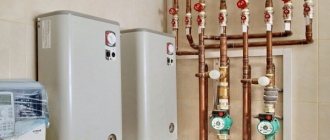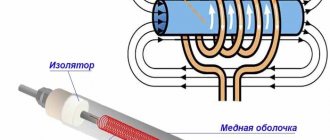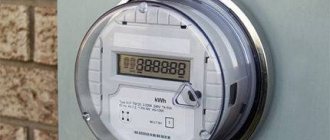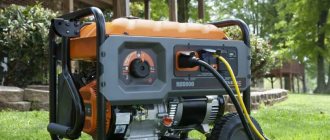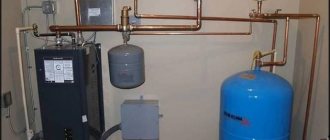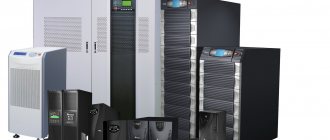The heating of a private house is an autonomous heating system, the reliability of which depends, first of all, on the boiler. The coolant heating device can operate on many types of fuel, including electricity.
Heating a private house with an electric boiler allows you to do without the use of solid fuel, which constantly needs to be loaded into the stove, and in comparison with gas equipment, an electric boiler for heating a private house is safer equipment to operate. In order to understand the features of electric boilers, we turned to the Miralex company, which specializes in heating and water supply systems for private homes.
Electric heating system in a private house Source remont-da.ru
General information
Electric heating boilers for private homes have been used for many years, but thanks to the development of microprocessor electronics, many current devices can be easily programmed to the desired operating mode for heating the living area. Modern electronic boilers are convenient because the operation of the heating system can be easily adjusted and electricity not wasted at a time when all residents leave the house, and when using a two-tariff meter, the device can be configured for maximum operation at night, when the cost of electricity is much lower.
Electric heating boilers Source ultra-term.ru
Electrode boiler: brainchild of the Navy
As we see, heating elements are a very good and important invention of mankind. Modern man can no longer live without them. But it is impossible to stop the engineering idea, so the matter was not limited to the invention of the heating element.
Now it is difficult to establish for certain whether this is true or a beautiful legend, but manufacturers of electrode boilers claim that they were originally developed for use on submarines. In principle, this is a plausible statement, since many of mankind’s inventions came into our lives from military design bureaus. Electrode boilers, at first glance, seem to be ideal water heaters: in fact, the water in them heats, one might say, itself. Here's how it happens:
An electrode electric boiler is a steel pipe with supply and discharge pipes. Electrodes are placed inside this tube. If the heater is single-phase (in electric boilers with a power of 2 to 6 kW), then there is one electrode, if it is three-phase (in boilers with a power of 9 to 50 kW), then there are three. The operation of an electrode boiler is based on the principle of ionization of water under the influence of electric current (which is why sometimes such boilers are also beautifully called “ionic”). As you know, if you place a positively charged electrode (anode) and a negatively charged electrode (cathode) in water, the ions begin to rush from one to the other, and since these ions are located in a medium that offers resistance (water), this medium heats up. When the electrode is connected to an alternating current network with a frequency of 50 Hz, the electrode changes its polarity 50 times per second, i.e. it will “be” the cathode 25 times and the anode the same number of times. If such a change did not occur, the electrode boiler, in addition to heat, would also produce pure hydrogen and oxygen, since the electrolysis reaction would occur in it. However, electrolysis can still occur under certain conditions, although not on the same scale as with a DC connection.
Perhaps the main feature of an electrode boiler is that to ensure the necessary heating parameters, the coolant must be prepared - ordinary network water will not work. And if the system is, for example, filled with distilled water, then no heating will occur at all. Therefore, the coolant for an electrode boiler must be specially prepared by adding special additives (salts). At its core, the coolant must be converted into an electrolyte. So the electrode boiler can operate only in strictly closed heat supply systems with the minimum possible coolant losses. In addition, special electrical protection measures are required, since the coolant is a conductive medium. Despite the assurances of electrode boiler manufacturers that their product is the most efficient electric boiler, this can be convincingly argued, because electrodes have a rather limited service life, and the need to prepare the coolant does not at all reduce operating costs.
So, let's summarize the results of electrode boilers:
| Advantages | flaws |
|
|
Features of using electric boilers
Electric boilers for heating a private home are convenient because their installation does not require installing a chimney to remove gases. Electrical installations are virtually silent and do not burn oxygen in the room.
The only disadvantage of such systems can be considered the possibility of electric shock and too high prices for consumed electricity. These shortcomings can be overcome if the equipment is installed taking into account safety regulations, and to save money, as mentioned above, a two-tariff electric meter is purchased.
With the right approach to using an electric boiler in a private home, such a system is not inferior to other types of heating installations, and in many respects significantly surpasses them.
Electric boiler with water heater in a private house Source sellprint.ru
Electric boiler with automation
Most often, electric boilers have an automatic control system. This fact is a great advantage for the user. After all, he will need to initially set the required temperature regime, after which the unit will work on its own.
More expensive products have a control unit with a microprocessor that allows you to set a home heating program. Here you can also set the temperature, operating time and everything. This function is quite convenient, because if there are no people in the house, then why heat it up at full power when you can save a little.
Before you start purchasing an electric boiler, you need to thoroughly study the range of products on offer, then calculate the required boiler power, check for heat losses in the room, and minimize them if possible. It is also worth considering what type of electric boiler is suitable and then buy the electric boiler that it needs for your home.
Boiler selection criteria
Currently, specialized stores sell electric heating boilers with many characteristics, and which ones are best for a private home can be very difficult to figure out. When choosing an electric boiler, you should first of all pay attention to the following criteria:
- power;
- type of heating element;
- manufacturer;
- availability of additional functions.
The power rating of the purchased device will determine whether the device can handle heating the living space of the house, and the type of heating element used in the boiler will determine its cost. The cheapest boilers are devices that use heating elements to heat the coolant, and the most expensive are induction units. Its price depends on how well promoted the boiler manufacturer is; in addition, the cost indicator will be influenced by the presence of additional functions of electrical equipment.
Electric heating system for a large country house Source stot64.ru
Detailed calculation of electric boiler power
The power for heating a private house, cottage or apartment with an electrical heating appliance is equal to thermal power. To calculate it, follow a few simple rules:
- for heating 1 cu. m of house or cottage will require about 40 W of power;
- for each of the windows you need to add 100 W, for the door - another 200;
- these data are averaged and depend on climatic conditions: residents of the Far Eastern and Siberian regions multiply the final number by 1.5–2, the coefficient in the middle regions of the Russian Federation is 1.2, and the southern regions use a coefficient of 0.7–0.9;
- for a house or cottage, the calculation result is multiplied by another 1.5, which is associated with heat loss due to the structure of the roof and floor surface (especially in the absence of a basement).
Let's give an example for a house in the south of the country with an area of 80 square meters.
m., with a ceiling height of 3 m, six window openings, one entrance door. House area – 80 sq.m. m. must be multiplied by 40 W, then multiplied by 3 (ceiling height indicator), add 200 and 600 W (door and windows). We multiply the resulting value by the private house and regional coefficient - 0.7 and 1.5. As a result, we get 10920 W. See also -
Comparison of the capabilities of electric boilers and convectors
How to choose a boiler for a private home
An electric boiler must fully cope with the task of heating a private home, so the device must be selected correctly in terms of power. For an accurate calculation, it is necessary to calculate the heat loss of the building. With this question, it is better to contact specialists who will not only determine the location of heat leaks, but also make the necessary calculations of the power of heating equipment. In general, you should choose devices that are 20–30% more powerful than necessary to provide heat for the entire house.
Electric boilers with heating elements
Such devices are most often used as the main or additional heating of a room. Electric boilers with heating elements can be either wall-mounted or floor-mounted. Floor-standing units, as a rule, are designed for high power and have large dimensions.
Considering the high probability of failure of the heating element, some models are equipped with two heating elements. Such installations are more reliable and allow you to fully heat the premises even if one heating element fails.
New heating element electric boiler Source kotlof.ru
Induction electric heaters
An alternating magnetic field is used to heat the coolant in induction boilers. Under the influence of strong alternating magnetic fields, the metal heats up and heat is transferred to the liquid in the tank. Thus, it is possible to completely isolate the electric heating element from the effects of liquid and salts dissolved in it.
Induction boilers are much more expensive than heating elements, but given the high reliability, efficiency and high power of such heating systems, experts recommend choosing to purchase boilers of this type.
Vortex induction heater Source nn.kotel-t.ru
How to properly connect an electric boiler to the heating system
Briefly about how to properly install an electric heating boiler in a private house. To begin installation work, we list the basic safety rules that must be observed:
- When connecting the equipment, the power must be turned off.
- The following distances must be maintained between the boiler and the nearest structural elements of the house: to the wall - at least 5 cm, to the ceiling - at least 80 cm, to the floor at least 50 cm, to the nearest pipe - at least 50 cm.
- The front panel must be freely accessible for maintenance.
- The connection network must be three-phase (380 V) to avoid spontaneous combustion and short-circuiting of the wiring.
- Wire connections must be protected from water and sealed. It is better to protect the cable with corrugation or a cable duct made of self-extinguishing material.
Step 1 - installation of an electric boiler
The floor-standing boiler is installed on a special stand, which is sold complete with the unit. The wall-mounted one is attached to the wall with anchors and dowels. The vertical and horizontal position of the boiler must be accurate - misalignments can lead to failure or premature wear of the equipment.
Step 2 - connecting the boiler to the electrical network
- An electric boiler usually has more power, so it needs to be connected not from an outlet, but from the mains. From the distribution box in the room you need to lay a separate line to the boiler installation site. It is better to hide the cable to protect it from accidental damage.
- The cable cross-section must be selected so that it can reliably withstand high loads. Electric boilers up to 7 kW can be connected to a single-phase network, which, as a rule, was preserved in old Soviet apartments. For small boilers up to 3.5 kW, a separate line is not needed; they can be connected directly to the outlet.
Step 3 - install protection
- A residual current circuit breaker (RCD) and a circuit breaker must be installed on the main panel after connecting the wires to the electric boiler. The purpose of RCDs and circuit breakers is to protect against short circuits and wiring overloads.
- A voltage stabilizer will be needed to prevent the boiler from failing in the event of voltage fluctuations. It is strictly forbidden to use the equipment without grounding. The grounding wire must go from the bus to the boiler body.
Step 4 - starting the boiler
After the wiring is connected, you need to make sure that there are no exposed contacts. All taps, couplings, joints, etc. must be inspected and verified. First, the valves and valves are opened, and then the power supply to the boiler is turned on. Temperature and pressure sensors must operate according to the instructions. In case of obvious deviations from the norm, turn off the boiler and call a licensed specialist.
Installation and operation of an electric boiler
You can install an electric heating boiler yourself. Depending on the type of unit purchased, the heating installation is mounted on the wall or on the floor. In both cases, installation is carried out in the following sequence:
- marking the location of the boiler;
- drilling mounting holes;
- installation of the boiler on anchor bolts;
- connecting the boiler to grounding;
- connecting the device to the heating system;
- connecting the device to the power supply;
- filling the heating system with coolant and removing air pockets;
- boiler startup.
If all of the above steps were performed correctly, the electric boiler will start and the heating system will begin to function normally. During operation of the boiler, it is necessary to monitor the coolant level in the tank. If it drops to a minimum, then add water to the normal value.
If leaks occur, to prevent the device from malfunctioning, it is necessary to immediately eliminate the depressurization of the system. Also, during operation, electric boilers for the home must be cleaned of dirt and the wiring connected to the device is in good condition.
Important! The installation and connection of an electric boiler should be done by professionals.
heating element. Just heating element. Tubular electric heater.
Tubular electric heaters are historically the first devices adapted to convert electrical energy into heat. The heating element was invented in the USA, as evidenced by the 1859 patent. Since then, this type of electric heating device has been the most common, mainly due to the relative simplicity of the design. It should be noted that fundamentally nothing has changed in the design of this device since its invention:
The heating element consists of a thin-walled (0.8 - 1.2 mm) metal tube (body), inside of which there is a spiral of wire of high electrical resistance. Due to this resistance, the spiral heats up. The tube material can be carbon steel if the surface temperature of the heating element in operating mode does not exceed 450 °C, and stainless steel at higher temperatures or when the heating element is operating in aggressive environments. The metal can be coated with a chemical or electrochemical coating - tinning, nickel plating, fluoroplastic.
The spiral is most often made of chromium-nickel alloy (more often you can find its other name - “nichrome”) or ferrochrome alloy. The ends of the spiral are connected to a contact rod, the outer part of which is connected to the power supply. The spiral is insulated from the body with a filler that has high electrical insulating properties and conducts heat well. Periclase (magnesium oxide) or quartz sand is most often used as a filler. After filling the filler, the heating element tube is pressurized. Under high pressure, the periclase crystals are soldered together, fixing the spiral along the axis of the heating element tube. The pressed heating element can be bent to give the required shape. The contact rods of the heating element are isolated from the tube with an insulator, and the ends are sealed with moisture-proof silicone varnish.
The unit power of a heating element varies from tens of watts to tens of kilowatts. The variation in size is even greater, and in terms of the shape of the heating element, the variety of heating elements is completely unparalleled - straight, spiral, arc-shaped and in general almost any shape that the customer or manufacturer comes up with.
As you know, the simpler the system, the less likely it is to fail. Despite its apparent simplicity, the design of the heating element has quite a few elements that do not serve well, namely: a red-hot coil, the temperature of which can reach 1000 °C; backfill filler, the uniformity of which directly determines the durability of the heating element; the presence of sealing layers and seals, on which not only the performance of the heating element depends, but also its fire and electrical safety - it is in such places that so-called “breakdowns” and short circuits are possible. But even without breakdowns, the voltage is still almost always transmitted to the housing, despite the filler, so electric boilers using heating elements necessarily require careful grounding.
Let's take a closer look at the pros and cons of heating elements as such (without the properties of electric heaters that contain them - we are interested in the heating principle as such):
| Advantages | flaws |
|
|
Disadvantages of heating with electricity
The main disadvantage of using electric boilers for heating a private home is the high probability of a power outage. This usually occurs during natural disasters and power line failures. Such troubles arise especially often in the winter season, when the heating operation should not be interrupted for a long period of time.
Considering the large power consumption of such devices, it is almost impossible to provide backup power to the heating system using batteries. The problem can only be solved by connecting powerful generators, which are expensive and consume large amounts of gasoline or diesel fuel.
If you need to connect a powerful heating installation, then, as a rule, such boilers are powered from a three-phase electrical network. Therefore, if in a populated area it is not possible to connect a voltage of 380 V, then heating with electricity will be unavailable for a large private house.
An important disadvantage of using electricity is the high cost of electricity, which only increases every year.
Heating options
If it is possible to connect to the gas mains, we recommend choosing a gas boiler without hesitation, even despite the complex process of its registration. Otherwise, from an economic point of view, electric heating boilers are not always justified.
Electric boilers are compact in size, require a minimum of wiring and have a modern design, which allows them to be installed anywhere.
The most financially profitable option is to temporarily use an electric boiler. For example, at a dacha or in a second country house, where the owners come only from time to time, but do not live permanently. In such cases, the 1.5-3 times lower initial cost of the boiler, its installation and connection will cover the cost of electricity during operation for a long time.
Since all electric boilers (with the exception of induction) are designed to use exclusively water as a coolant, which freezes at subzero temperatures, it would be desirable in such a situation for the boiler to have the ability to connect external control. For example, using a GSM module or Wi-Fi module. Firstly, this will allow you to control the electric boiler remotely and set the desired temperature before arriving at the house. Secondly, remote control will give you confidence that in the absence of the owners the boiler maintains a positive temperature and the system is not damaged (otherwise you will immediately receive a notification).
Another great option is to use an electric boiler as an additional or backup heating equipment. For example, in a scheme using a buffer tank in case of problems with the operation of the main boiler and heating at a night tariff, or for a heated floor circuit. For such purposes, an inexpensive 3-6 kW electric boiler costing 11-15 thousand rubles, operating from a single-phase power supply, is quite sufficient. It will be able to maintain temperatures above +18°C in a house of about 100 square meters. m. for 2-2.5 days or completely ensure the normal temperature of the heated floor on an ongoing basis.
A simple and compact low-power model EVAN EPO.
Water-heating electric boilers can be used as the main heating equipment only if you have a free budget. The only exceptions are small and insulated houses with an area of up to 90-100 m2. To heat such an area, taking into account medium or dense insulation, an inexpensive electric boiler with a capacity of 6-9 kW will be sufficient. The low cost of the boiler unit and its installation, as well as the absence of the need for its coordination with Energonadzor services, will pay off the high operating costs for another 1-3 heating seasons.
Specifications
The technical characteristics of an electrical device include power, number of circuits, efficiency, connection method, material of parts and housing, as well as the type of automation and dimensions of the device.
Unit power
The power required to heat a room is roughly calculated: 1 kW per 10 square meters. But when choosing power, other characteristics are also taken into account: wall thickness, ceiling height, heat loss due to an uninsulated ceiling or old wooden windows, the number of chambers in double-glazed windows on metal-plastic windows, the total area of windows in a house or apartment. You should also take into account the climate in a particular region.
There is no exact formula to calculate how much electricity is consumed when the boiler is operating. Here you need to understand that electrical equipment consumes as much energy as it leaves the room during the cold season.
It is profitable to buy equipment that has a representative office in the region in order to carry out high-quality repairs if necessary. Domestic electric boilers are made with high quality and are cheaper, but in a certain region there may not be a specialist familiar with the design of the models.
Boilers may have a different type of power control - smooth or stepped. If the unit has additional heating power, the type of adjustment will be stepped. Typically, the main element provides half of the total power, the other two - 25% each. If necessary, you can disable additional elements.
Efficiency of electric boilers
It is useless to choose an electric boiler based on efficiency, since all models have a high rate - from 96 to 98%. Energy conversion, rather than generation, is the principle of all heating equipment of this type.
Number of circuits
If the boiler has one circuit, it will only work to heat the room. In this case, it is recommended to take care of the method of heating the water. Double-circuit equipment is capable of switching from heating a room to heating water for users.
Connection method
You can choose a single-phase or three-phase boiler - 220 and 380V, respectively. Depends on what type of electrical wiring is in the house. The power of a single-phase unit will be less, and that of a three-phase unit will be greater.
Materials
It matters for the service life what materials the internal parts and housing are made of. The metal frame can withstand shock loads, so it is more profitable to buy it. Basically, all manufacturers produce boilers in a metal casing.
Automation type
In electric boilers, one of two types of automation is installed to control the air temperature in the room: electronic or mechanical. In the first case, the circuit opens when the temperature reaches the desired level. The second has a remote sensor that controls the temperature. When it is reached, the device transmits a signal to the control unit and it turns off the unit.
When the temperature drops to a certain level, the equipment turns on again without human intervention. If you set the lower and upper temperature thresholds in the minimum range, the boiler will turn on and off more often. This affects its service life in the case of a heating element boiler.
Equipment
There is a basic configuration of electric boilers and additional options. The second option is more expensive, but it may turn out that subsequent installation of options will lead to an increase in the price of the device several times, including the work of a specialist. Additional options include:
- draining water automatically if the equipment is not used at low temperatures;
- pressure control in the system;
- centrifugal pump to enhance fluid circulation through pipes;
- filter for water purification;
- remote sensor for temperature control in distant rooms.
Sometimes it is necessary to use an expansion tank, so it is purchased separately, since it is not included in the basic package of the device.
What affects electricity consumption
All boilers convert the energy used into heat in a 1:1 ratio. With 100% efficiency, negligible losses in wires and connections are neglected. The exception is heat pumps, but they are still rarely used.
Thus, there are only 2 ways to reduce electricity consumption:
- Reduce heat loss. To do this, the home is covered with mineral wool or polystyrene foam, and the cracks are sealed.
- Optimize the operation of the boiler in order to eliminate excessive consumption of energy resources.
The second problem is also solved in 2 ways:
- Using weather-sensitive automation. Such a system promptly warns the boiler about the onset of warming, and it manages to reduce power without overheating the room.
- Programming. A model with this function, according to user settings, reduces heating output when residents are at work or sleeping. The rest of the time the device returns to normal mode.
For inexpensive heaters, the first option is not suitable. They do not have the function of connecting weather-compensated automation. Then it is recommended to install at least a remote thermostat: it maintains the room temperature at a given level.
It is possible, without reducing consumption, to reduce financial costs. They are switching to differentiated metering of electricity consumption with a big discount at night (RUB 1.68 instead of RUB 3.89). The heating system is equipped with a heat accumulator - a large capacity in which the boiler raises the temperature of the working environment to +98˚C within a grace period. During the day, boiling water is gradually supplied from it through the mixing unit into the circuit as needed; the heater does not work at this time.
In this case, you will have to pay 17,388 × 1.68 = 29,212 rubles for the season. But there is a nuance: the rated power of the boiler should be twice the design power, because at night it works both for heating and for “charging” the heat accumulator. For the example given, a 20 kW unit will be required.
When an electric boiler is the best solution
Gas is not available to everyone: some settlements are located too far from the main line, and sometimes installing a gas boiler is not at all advisable. For example, for a country house that is heated several times during the winter, there is no point in purchasing an expensive set of gas equipment.
Solid fuel boilers also have a number of disadvantages: it is necessary to prepare and store fuel, and most solid fuel units cannot operate for a long time, more than 4-5 hours, on one load of fuel. In addition, they are inertial and do not allow precise temperature control. In this case, an electric boiler can solve the heating problem quickly, reliably and at no extra cost.
Advantages of electric boilers for a private home:
- easy to install, connect and maintain;
- have a high level of automation;
- Allows you to accurately set the desired temperature;
- work silently;
- no connection to the chimney required;
- do not require a separate room; most household models are mounted on the wall with your own hands.
Flaws:
- require connection to the panel with a separate cable;
- boilers with a power of more than 9 kW are produced only for three-phase voltage 380 V;
- Due to high electricity tariffs, heating costs several times more.
Calculation of power for the area of the house
We present a simplified calculation of power, since this issue is a topic for a separate article. Approximate calculation usually always gives results as close as possible to real needs.
If the electric boiler performs an auxiliary heating function in addition to the main gas or other unit, or fireplace, then for 120–150 m² a power of 3–6 kW will be sufficient.
Comparative table of average statistical electricity consumption by electric boilers
| Boiler power | Heating area, m² | Consumption, kW/hour | Boiler power | Heating area, m² | Consumption kW/hour |
| 3 kV 1 phase | 50 | 0.5–0.6 | 3 kV 1 phase | 30 | 1.5–1.8 |
| 5 kV 1 phase | 80 | 0.9–1.2 | 5 kV 1 phase | 50 | 2.0–2.5 |
| 9 kV 3-phase | 120 | 1.8–2.3 | 9 kV 3-phase | 90 | 3.6–4.2 |
| 25 kV 3-phase | 350 | 4.5–5.5 | 25 kV 3-phase | 240 | 9.5–11.0 |
If an energy-saving boiler is the main source of heat, then it is necessary to carry out calculations taking into account heat losses, which for an average private home with two-brick masonry and 2.7 m ceilings in the climate of the Moscow region is 1 kW/hour. It is recommended to select power with a margin of 10–20%, and for heating element heaters - by 20–30%, since their efficiency decreases due to scale. For 80 m² you will need an electric boiler of 9.6–10 kW (8 kW + 20%).
For SAV boilers, a power of 2.5 kW is 2100 kcal/hour, which is enough to heat 25–30 m². The calculation is affected by the required temperature. If you need to maintain 15–20 degrees in a room of 120 m², then a 6 kW unit will suffice.
An economical ion-type electric heating boiler with a power of 3 kW is suitable for heating 50 m². The same product with a heating element will heat 30 m².
What to choose: comparison of consumption, cost, ease of use
If we focus on ease of installation, ease of operation, and average price, then the first place in the ranking is occupied by boilers with heating elements. As a standard, they are carried out in a monoblock case that is completely ready for operation after installation - it already has a safety group, an expansion tank, a circulation pump and other elements. You just need to connect it to the input and output of the heating system. But they are in last place in terms of economy and cannot be called energy-saving.
If we consider the question of which electric boiler is the most economical and with the best energy saving, then we should consider induction and ion units.
Vortex heaters are in first place in terms of economy, but they have a number of disadvantages that slightly offset this advantage: price, difficulty in repair, large dimensions. These are the most expensive and inconvenient electric boilers considered: the cost of such a 25 kW product is 86 thousand rubles. (A new heating element for 24 kW can be bought for 46 thousand).
Below is a table comparing different types of electric boilers. But the data in it should not be unconditionally trusted - manufacturers are trying to show their products in a favorable light. For example, in other sources, ion boilers are shown to be much more economical and efficient than heating element boilers.
| heating elementnew | Electrode | Induction | |
| Efficiency | 98 % | 94 % | 99 % |
| Loss of power after 12 months of use | 20 % | 15 % | 0 % |
| Maximum pressure | 3 atm | 3 atm | 6 atm |
| Heating temperature | Up to 90 degrees | Up to 85 degrees | Up to 115 degrees |
| Life time | 3–7 years | 10–12 years | 30–60 years |
| Probability of failure within 12 months | 15–20 % | 15–35 % | 0 % |
Another disadvantage of SAV and VIN is the large dimensions of the housing itself and the individual elements that include the control cabinet. A product with a tubular electric heater contains everything you need in a compact case, and an ion boiler generally resembles a thick water pipe. The weight of a 25 kW induction boiler is 80 kg, a heating element of the same power is 40 kg.
Vortex boilers are increasingly being chosen for private homes. Although such devices are the most energy-saving, they are more often used in places where induction heating is indispensable - in industrial, production environments, and chemical plants.
Economics of VIN use
| The name of a room | Heated area/volume | VIN model | power, kWt | Cost kW/h, rub. | Monthly payment, rub./month. | Payment for the heating period, rub. |
| 1 room apartment | 50 m² | VIN-3 | 3 | 2.0 | 1227.6 | 9147.6 |
| House | 100 m² | VIN-7 | 7 | 2.2 | 2864.4 | 21334.4 |
| Garage box | 450 m³ | VIN-10 | 10 | 3.2 | 5952 | 45888 |
| Hangar | 1000 m³ | VIN-20 | 20 | 3.2 | 11904 | 91776 |
Ion (electrode) boilers are the best choice in the economy class in all respects, especially in terms of cost, if you need an energy-saving heater for heating a private home. Their economy and efficiency may be somewhat lower than that of induction and heating elements products, but this is compensated by ease of maintenance and small size. An important fact in favor of ion boilers is the price - these are the cheapest energy-saving heaters for heating (4-5 thousand rubles).
Ion boilers are a good option as an additional heating source. If you use them as main devices, you can embed several of these cylinders for greater efficiency.
General features of electric boilers
Among the parameters common to all models, it is necessary to mention the implementation with one or two circuits. The first units can only heat buildings, while the second ones are also capable of preparing hot water for domestic needs.
All electrical devices up to 9.0 kW do not require permits and can operate from a 220 V network, however, their installation is not as simple as, for example, boilers. The fact is that such devices place a significant load on the electrical network. For this reason, special care must be taken to ensure the safe connection of equipment to the mains.
Operation of the devices is characterized by simplicity. Their adjustment is carried out using adjustment panels, which can be included in the kit or purchased separately.
Installation and connection
There are no special rules for installing an electric boiler, but there are general points that need to be followed:
- It is better to place the device in a separate room where younger family members cannot reach.
- The power cable is laid so that water does not get on it. For this purpose, plastic or metal boxes are used. For the same reason, cables should not be laid under water pipes.
- The pipes are attached to the wall so that their weight does not damage the body and parts of the boiler.
- The cross-section of the wire must correspond to the current strength, and the unit body must be connected to a grounding device.
To begin with, the body is attached to the wall using special canopies. The height above the floor level for a heating element boiler is at least 1.5 m. Other models can be installed lower. Usually at the bottom of the boiler there is an inlet pipe for cold or cooled liquid, and at the top there is an outlet pipe for hot water. The pipes are connected to the pipes using American taps.
An expansion tank and a mud pan are mounted to the return flow line to collect debris or pieces of scale. There should be a tap nearby for cleaning the mud tank.
For induction boilers, the installation is more complicated, since it is necessary to embed a circulation pump into the main line, as well as a safety group: a pressure gauge, a safety valve and a device for removing air from the system. A sump tank and an expansion tank are also installed on the return line.
Particular attention is paid to the selection of cable cross-section and installation of the control unit for emergency shutdown of the device. The work is carried out according to the scheme specified in the technical data sheet of the boiler.
Main types of electric boilers for home
All models can be divided into three modifications, which differ in the heating element used. They are:
- heating elements,
- induction,
- electrode.
Although all of these types use electricity, the principle of their operation is different.
Electric boiler with heating element
These models are widely in demand among Russian consumers. They are simple and convenient, and their design reminds everyone of familiar devices - electric kettles or boilers. The advantages of the units lie precisely in their simple design. Among the disadvantages are a high rate of inertia and the need for a good temperature carrier.
Induction electric boiler for heating
In such equipment, the temperature of the coolant increases using an electromagnetic field. Units of this type boast wide advantages:
- high efficiency indicators of energy resource use;
- no need for frequent maintenance;
- incredibly long operating period;
- rapid heating of the liquid in the circulation line;
- precise adjustment of operating parameters.
The disadvantages are the large mass of devices and noticeable noise during operation. Another disadvantage of an induction electric boiler is the price. It is quite high compared to heating element models.
Electrode boilers for private homes
These aggregates are also called ionic. Household models of this type are equipped with electrodes between which current flows. As a result of this process, heat is released, which is used to heat the liquid. This operating principle determines various pros and cons of devices.
Positive aspects of the equipment:
- very compact dimensions;
- prompt access to operating temperature;
- high accuracy of heating parameters adjustment;
- complete safety of operation;
- nice price range.
Among the negative features, it should be noted that the maximum heating temperature is only 75 degrees. Also in this series is the inability to work with cast iron and steel batteries, greater capriciousness in operating conditions, special needs for grounding and the need to replace electrodes from time to time.
Energy savings
Running an electric boiler will consume energy, for which you have to pay and the prices for which are constantly rising. In order not to waste your finances, it is recommended to carry out work to reduce heat loss, which can occur through cracks in wooden windows, single-glazed windows in metal-plastic structures, uninsulated ceilings or ceilings between floors, roofs not sealed with insulation, as well as the floor.
For insulation, you can use inexpensive materials - mineral wool, polyethylene foam, polyurethane foam.
